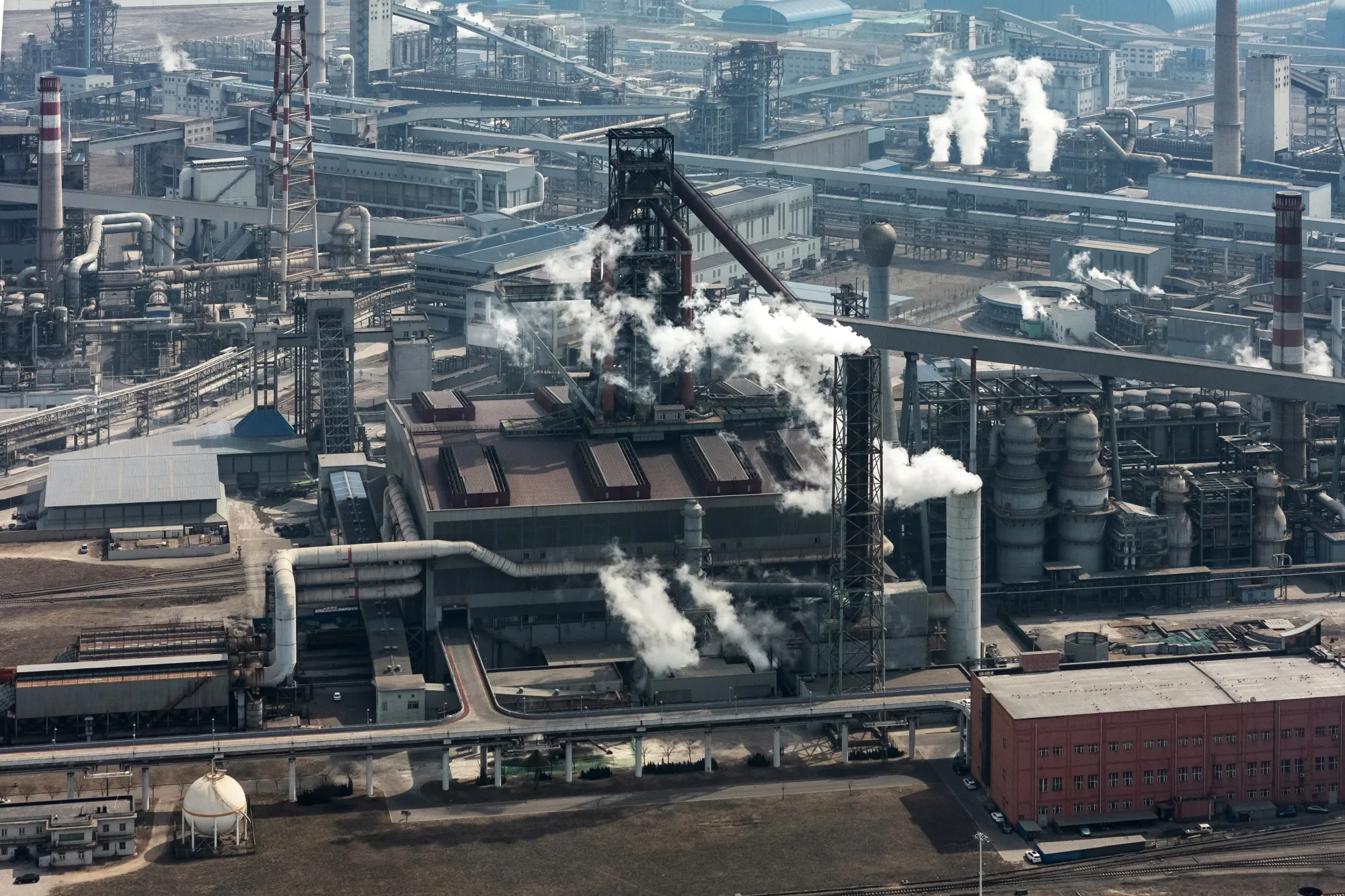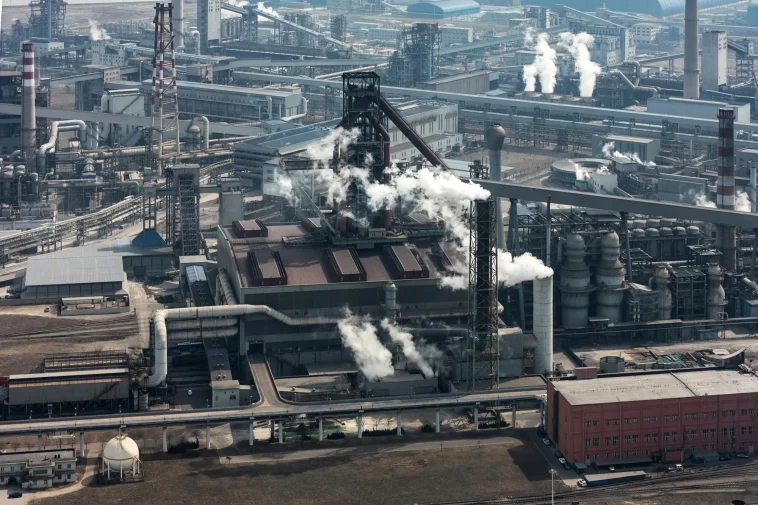
China’s Green Steel Transition: An Ambitious Vision and Its Challenges
In recent years, China’s commitment to reducing carbon emissions has been in the spotlight, particularly in heavy industries such as steel manufacturing. The move towards greener production methods, while full of promise, is also riddled with challenges. Among these, the transition to electric-arc furnaces (EAFs) stands out as both an essential step and a tough hurdle. The country’s current output from EAFs, estimated at around 10% of its total steel production for this year, falls well short of the target surpassing 15%. This critical gap raises questions about the feasibility of China’s green steel ambitions and the economic implications for the industrial sector.
There is no denying that the idea of a greener steel industry is not only an environmental imperative but also a key business opportunity. However, the journey is far from simple. The production process using EAFs, although more cost-intensive, boasts greater efficiency and lower carbon emissions compared to traditional methods. This technological shift, however, represents a series of tricky parts and tangled issues that require careful planning and substantial investment. As industrial leaders and policymakers work together, the current scenario underlines the need for a strategic recalibration and enhanced support for promising green technologies.
The ongoing debate is not just about meeting emissions targets—it is also about managing your way through a competitive global market. With examples from countries like the United States, where approximately 72% of production utilizes electric furnaces, China finds itself at a crossroads of reform and industrial rivalry. As we take a closer look at the hurdles ahead, it becomes clear that solving these problems is as much about upgrading manufacturing capabilities as it is about adjusting business models and government policies.
Electric-Arc Furnaces: The Backbone of a Greener Steel Industry
The role of electric-arc furnaces in modern steel production cannot be overstated, even though the technology is still on the path of widespread adoption in China. EAFs provide a method to recycle scrap steel and reduce reliance on coal-based blast furnaces. While the technology is not entirely new in Western markets, its integration within China’s massive steel economy presents unique and nerve-racking challenges.
One of the major advantages of EAFs is that they allow for better control over carbon emissions and energy consumption. Yet, the higher operational costs and the need for a constant supply of quality scrap steel make the process intimidating for many manufacturers. Moreover, the delicate balance between environmental benefits and economic feasibility introduces subtle details that companies must consider. As the nation strives to find a path to sustainable growth, identifying the fine points of such technologies—as well as their limitations—remains a super important task for industry experts and policymakers alike.
For a clearer illustration, consider the following bullet list that outlines critical benefits and challenges associated with EAF implementation:
- Benefits:
- Reduced carbon footprint compared to traditional methods
- Enhanced recycling capabilities
- Improved energy efficiency over time
- Challenges:
- Higher initial capital expenditure
- Dependency on scrap steel supply
- Technical know-how for process optimization
Clearly, while the electric-arc furnace promises a more sustainable future for steel production, making your way through the required investments and operational adjustments will not be a short or straightforward journey.
Economic Pressures and Industrial Manufacturing Adaptation
China’s manufacturing community is working through a delicate balancing act between maintaining economic growth and transitioning to greener production methods. On one hand, a move to greener steel production can help the environment and align with global trends towards sustainability. On the other hand, the significant capital investments required, along with the nerve-racking changes needed within traditional production frameworks, can create considerable tension within the industry.
The current economic scenario puts manufacturers in a position where they must figure a path that reconciles immediate financial pressures with long-term sustainability goals. Many companies express concerns over the initial costs of adopting electric-arc furnaces. In addition, the potential disruptions in the supply chain of scrap steel and the need for upgrading existing facilities further complicate the situation.
Some of the noisy points that the industry is wrestling with include:
- How to allocate funds for technology upgrades without compromising day-to-day operations
- Managing potential supply chain disruptions during the transition
- Maintaining competitiveness in both domestic and international markets
From a small business perspective, these issues are not only a matter of industrial policy but also of grassroots economic stability. Many smaller plants face overwhelming challenges, forcing them to adopt cost-saving measures that may delay or even derail the transition. This situation is emblematic of broader economic pressures where companies must use careful navigation strategies to balance survival with progressive environmental practices. Thus, the struggle is as much about the fine shades of business economics as it is about the larger goal of reducing carbon emissions.
Government Policies and International Comparisons
Government regulations and incentives play a critical role in supporting the green steel transition. In an industry full of problems and tangled issues, robust policy support can reduce the risks associated with new technologies like electric-arc furnaces. Beijing’s policies to lower carbon emissions are undoubtedly aggressive. However, the implementation of these policies must be supported by effective measures that can steer through both technical and economic challenges.
When we look at international standards, there is a clear gap between the progress seen in China and that in markets such as the United States and Europe. While China has set bold emission targets, these are offset by the relatively low adoption rate of EAF technology, currently hovering around 10%. In contrast, international counterparts have successfully integrated EAFs into their production lines, such as in the U.S. where the rate is reported at an impressive 72%.
The following table offers a side-by-side comparison of key metrics in steel production methods between China and other major markets:
| Metric | China | United States | Global Average |
|---|---|---|---|
| Percentage of Steel Produced via EAF | 10% | 72% | 29% |
| Cost of Production (Relative Scale) | Higher for EAFs | Optimized over time | Varies by region |
| Emission Reduction Efficiency | Improving but behind target | Leading in efficiency | Mixed results globally |
This clear juxtaposition emphasizes the stark differences in adaptation and the need for enhanced support systems within China. Policy makers need to quickly figure a path that not only incentivizes the adoption of cleaner technology but also provides financial and technical assistance to manufacturers grappling with the confusing bits of upgrading their production lines.
Barriers to Widespread Adoption of Electric-Furnace Technology
Despite the promising benefits, several barriers are limiting the widespread adoption of electric-arc furnace technology in China. These barriers are not solely technological—they are tangled issues involving economic, infrastructural, and regulatory factors. As the industry tries to work through a maze of challenges, companies both large and small are finding it nerve-racking to implement changes that require significant capital and training investments.
A few of the most prominent barriers include:
- High Operational Costs: Electric-arc furnaces require a substantially larger upfront investment, a factor that many traditional plants find intimidating. The conversion from blast furnaces to EAFs involves expensive equipment upgrades and substantial training for personnel.
- Supply Chain Interruptions: Securing a reliable supply of high-quality scrap steel is a fine detail that many operations have yet to perfect. Unlike traditional methods that rely on raw iron ore, EAF technology depends on an efficient recycling infrastructure.
- Technological Adaptation: Transitioning to new technology means that the workforce must be retrained. Many companies have expressed concerns about managing your way through these fine points without experiencing significant disruptions.
- Governmental and Regulatory Hurdles: While policies exist to encourage greener steel production, the implementation mechanisms can be overloaded with red tape, making the process of securing incentives and subsidies more complicated than anticipated.
Furthermore, these barriers are compounded by the industry’s historically strong reliance on conventional methods. The established processes and deep-rooted supply chain systems mean that any shift towards an alternative production method involves a series of complicated pieces. Without a coordinated push from both the government and private sectors, these headwinds are likely to continue stalling progress.
Adapting to Market Demands in a Changing Global Landscape
In the global market, businesses are continually challenged to balance the need for sustainable practices with the demand for economic efficiency. China’s steel producers are no exception. The need to adapt to market demands while embracing greener technologies creates a scenario loaded with issues that are both exciting and overwhelming.
Businesses must now figure a path that merges operational cost management with environmental responsibility. For many companies, this means evaluating whether to upgrade existing facilities or to invest in entirely new production lines. The decision-making process is full of tricky parts and subtle details, including risk management, technological integration, and competitive positioning in the global market.
Key considerations when adapting include:
- Assessing the long-term cost benefits versus the short-term financial burdens
- Determining the feasibility of integrating new systems with legacy equipment
- Working through the scalar challenges of scaling up production without sacrificing quality
From a small business standpoint, these concerns resonate deeply. Many smaller firms may lack the resources to undertake such nerve-racking transitions independently. This scenario calls for collaborative models where larger industry players and government agencies work together to create a more supportive ecosystem. A coordinated strategy would help demystify the complicated pieces of the transition, making it less intimidating for businesses that are already operating on razor-thin margins.
Strategies for Overcoming Industrial Hurdles
Given the current state of China’s green steel transition, industry experts advocate for a multifaceted approach to address the mixed set of challenges. One effective strategy is for the government to offer more targeted subsidies and incentives that directly offset the higher costs of EAF installation. These economic policies can serve as a springboard for rapid industrial adaptation.
Additionally, partnerships between the private sector and academic institutions could be promoted to develop better training programs. This would allow the workforce to dive in and get up to speed on the subtle parts of the new technology, easing the transition from blast furnaces to electric-arc furnaces. By lowering the barrier to entry of these new technologies, companies can more readily adopt environmentally friendly practices.
Here are some actionable strategies that stakeholders might consider:
- Financial Incentives: Redirect state funds towards grants and low-interest loans specifically designed for upgrading to green technologies.
- Collaborative Research: Promote joint research initiatives to innovate cost-effective methods for incorporating EAFs into existing production chains.
- Workforce Development: Invest in education and training programs focused on the technical and operational aspects of electric-arc furnace technology.
- Infrastructure Improvement: Modernize the supply chain to ensure a steady and quality source of scrap steel, essential for efficient EAF operations.
Each of these approaches deals with a different set of tangled issues, yet together they form a cohesive plan to accelerate the green transition. The incorporation of structured support systems could eventually lead to a scenario where the adoption of EAF technology is not seen as intimidating but rather recognized as a critical step toward sustainable industrial growth.
Long-Term Economic Implications for Global Competitiveness
In the grand scheme of economic progress, the decision to invest heavily in green technologies like electric-arc furnaces can have broad implications for global competitiveness. As green steel gradually becomes more integral to production processes, nations that can streamline the transition are likely to enjoy a competitive edge on the global stage. China’s current setbacks in meeting its set targets are a cautionary tale of how not addressing the small distinctions in operational efficiency and cost management can hinder progress.
Taking a closer look at the long-term picture, the challenge is not just about meeting environmental standards. It is also about redefining the landscape of industrial manufacturing for decades to come. This transformation can foster innovation, promote sustainable practices, and ultimately reshape the economic outlook of nations that undertake the change.
On a global scale, countries with advanced EAF technologies and more efficient production processes are positioned to reap a host of advantages:
- Reduced Carbon Footprint: Lower emissions help these countries meet international climate obligations and enhance their reputations as responsible industrial leaders.
- Economic Efficiency: Over time, improved energy use and optimized technology can translate into lower production costs, making exports more competitive.
- Technological Leadership: Pioneering green manufacturing methods can spur further innovations and investments in sustainable technologies.
For China, aligning with these global trends is not simply about catching up but about establishing leadership in a sector that is rapidly becoming the new benchmark for responsible production. To do so, it must address the tricky parts and overwhelming challenges head-on, embracing the fine details of modern manufacturing processes and investing in the long-term sustainability of its industrial base.
Market Innovations and the Future of Green Manufacturing
The push for green steel production is spurring market innovations that extend well beyond traditional manufacturing practices. As environmental concerns become more mainstream, new business models and technological advancements are emerging, ready to redefine what sustainable production looks like on a global scale.
One of the most exciting developments is the integration of digital technologies and artificial intelligence in monitoring and optimizing production processes. These tools have the potential to address many of the confusing bits that come with transitioning to electric-arc furnaces, offering real-time data and insights to help companies figure a path forward. With enhanced monitoring, manufacturers can responsibly steer through fine shades of cost management and technical adaptation.
In addition, several emerging business models are focusing on circular economy principles, where waste is minimized and each component of production is recycled or repurposed efficiently. This is particularly relevant in the context of steel manufacturing, where scrap steel has become a valuable resource for EAF-based processes.
The innovations in this sector can be summarized into the following key areas:
- Digital Process Optimization: Adoption of advanced software to monitor energy use and production efficiency in real time.
- AI-Driven Predictive Maintenance: Utilizing machine learning to predict equipment failures and schedule maintenance before breakdowns occur.
- Circular Economy Integration: Rethinking production models to incorporate recycling and repurposing waste effectively.
These market trends represent not just a shift in operational strategy but a transformational change in how green manufacturing is perceived. The small distinctions in process efficiency and the ability to manage your way through complex production data are becoming super important markers for success in this evolving industry.
Policy Outlook and Recommendations for a Sustainable Future
Given the layered challenges and the promising potential of electric-arc furnace technology, there is a pressing need for well-rounded policy support. Policymakers must take into account the nerve-racking economic pressures and the subtle details that small, medium, and large manufacturers face alike.
The recommendations for a successful transition include:
- Enhanced Financial Support: Subsidies and tax breaks should be tailored to offset the higher costs of EAF technology. This direct support can reduce the intimidating financial burden on companies.
- Streamlined Regulatory Frameworks: Simplification of the bureaucratic process to secure incentives would allow businesses to shift gears more rapidly, reducing the uneven hurdles they face during transition periods.
- Public-Private Partnerships: Collaboration between the government and industry leaders can boost research and development in green technology, harnessing a network of experts to dig into the fine points of operational challenges.
- International Cooperation: Learning from global best practices and forming international alliances can bolster domestic efforts, ensuring that China’s green steel transition is competitive and sustainable.
From an economic standpoint, these steps are not just about meeting environmental targets—they also foster a business-friendly environment where innovation is encouraged and the twists and turns of industry challenges are met with strategic support. By taking these actions, China can position itself as a leader in sustainable manufacturing, setting the stage for an industry that is both economically viable and environmentally responsible.
A Path Forward: Embracing Change and Overcoming Hurdles
In conclusion, China’s green steel transition, though presently stalling due to low electric-furnace output, embodies a critical turning point for one of the world’s largest manufacturing nations. The journey to integrate electric-arc furnaces as a mainstream production method is tangled with issues ranging from high operational costs and supply chain disruptions to the intricate balancing of economic pressures and environmental imperatives.
For the industry to truly embrace change and overcome these hurdles, a dual approach is necessary—one that involves both innovative technological integration and supportive government policies. Companies need to steer through the confusing bits of upgrading their production lines by investing in research, training, and digital process optimization. Likewise, policymakers must create an environment where these investments can thrive by reducing red tape and offering targeted financial support.
At its core, the discussion about China’s green steel shift is about finding a path that reconciles economic growth with environmental sustainability. It’s about rethinking long-held practices and embracing a future where the production process is as clean as it is efficient. The current shortfall in meeting EAF adoption targets is a wake-up call—a signal that the traditional ways of manufacturing may no longer align with the demands of a changing world.
If manufacturers, policymakers, and technology providers can work together to manage their way through these complicated pieces, the rewards could be transformative. The benefits extend well beyond reducing carbon emissions; they include a potential leap in global market competitiveness, a stronger reputation for innovation, and, most importantly, a more sustainable industrial future.
Ultimately, the green steel transition is not a short-term project but a long-term commitment. As the world increasingly focuses on sustainable practices, the small business community, the industrial giants, and government agencies alike must all find their path forward. Learning to work through the tangled issues with careful planning, judicious investment, and a spirit of collaboration is key to not only reaching the desired emissions targets but also ensuring that China—and by extension, the global steel industry—can lead the way in a new era of responsible production.
The journey ahead is undoubtedly challenging, and while the electric-arc furnace represents a promising avenue for change, the road to widespread adoption is paved with both opportunities and pitfalls. By recognizing and addressing the underlying economic pressures and technical challenges, stakeholders can transform what seems today full of problems into a future defined by innovation, sustainability, and economic vitality.
As global environmental concerns intensify and markets become ever more competitive, the fine details of policy implementation, technology adoption, and business strategy will determine who emerges as leaders in the green revolution. With concerted effort and cooperation, the challenges of the green steel transition can be met head-on, paving the way for an industrial future that is both economically robust and ecologically responsible.
Originally Post From https://www.bloomberg.com/news/articles/2025-09-25/china-s-green-steel-transition-set-back-by-low-electric-furnace-output?srnd=homepage-europe
Read more about this topic at
China’s Green Steel Transition Set Back by Low Electric- …
Global Industry Steps Back from Green Steel amid …


